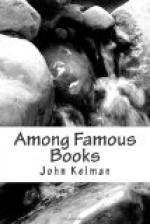As a key to mythology this theory was especially associated with the name of Plutarch among ancient writers, and it has been accepted more or less completely by a vast number of moderns. In the late Sir George Cox’s fascinating stories it was run to utter absurdity. The story is beautifully told in every case, and when we have enjoyed it and felt something of the exquisiteness of the conception and of the variety and range of thought exhibited in the fertile minds of those who had first told it, Sir George Cox draws us back sharply to the assertion that all we have been hearing really meant another phase of sunset or sunrise, until we absolutely rebel and protest that the effect is unaccountable upon so meagre a cause. It is an easy method of dealing with folk-lore. If you take the rhyme of Mary and her little lamb, and call Mary the sun and the lamb the moon, you will achieve astonishing results, both in religion and astronomy, when you find that the lamb followed Mary to school one day. This nature element, however, had undoubtedly a very considerable part in the origin of myths, and when Max Mueller combines it with philology it opens a vast field of extraordinarily interesting interpretations resting upon words and their changes.
A further theory of myths is that which regards them as the stories of races told as if they had been the lives of individuals. This, as is well known, has had permanent effects upon the interpretation not only of Greek but of Hebrew ancient writings, and it throws light upon some of those chapters of Genesis which, without it, are but strings of forgotten and unpronounceable names.
But beyond all such explanations, after we have allowed for them in every possible way, there remains a conviction that behind these fascinating stories there is a certain irreducible remainder of actual fact. Individual historic figures, seen through the mists of time, walk before our eyes in the dawn. Long before history was written men lived and did striking deeds. Heroic memories and traditions of such distinguished men passed in the form of fireside tales from one generation to another through many centuries. Now they come to us, doubtless hugely exaggerated and so far away from their originals as to be unrecognisable, and yet, after all, based upon things that happened. For the stories have living touches in them which put blood into the glorious and ghostly figures, and when we come upon a piece of genuine human nature there is no possibility of mistaking it. This thing has been born, not manufactured: nor has any portrait that is lifelike been drawn without some model. Thus, through all the mist and haze of the past, we see men and women walking in the twilight—dim and uncertain forms indeed, yet stately and heroic.




